Canterbury Shaker Village
Saturday, September 30, 2006We didn’t have a lot of expectations about the
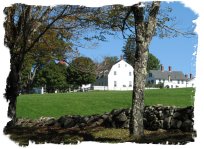 As usual, my half baked impressions were badly wrong. The Shaker story is an amazing one, and their beliefs, resulting directly in the beautiful design and craftsmanship so admired today in Shaker handiwork, are to be admired, not laughed at.
As usual, my half baked impressions were badly wrong. The Shaker story is an amazing one, and their beliefs, resulting directly in the beautiful design and craftsmanship so admired today in Shaker handiwork, are to be admired, not laughed at.
The Shakers, an offspring of the Quakers (Shaking Quakers), were so named because of their boisterous dances during religious ceremonies, and their belief in ‘shaking off sin’ through the movements. Although this sounds a bit offbeat, it makes more sense upon learning about their beliefs. With the motto ‘Hands to Work, Hearts to God’, the Shakers believed in constantly striving for perfection as a way to honor God. This strive for perfection was in everything they did, from washing clothes (the US Army during WWI consulted with the Shakers to learn how to sanitize and wash clothing efficiently on a large scale), to the famous furniture and architecture.
Although regarded by the modern day world as a failed religion – there is only one small surviving Shaker ‘family’, (down from a high of 10,000 members and 19 communities), the Shakers managed one of the longest and most successful socialistic experiments in history. For over 200 years the Shakers lived together in a communal fashion, without private ownership of capital goods. Unlike other religious groups such as the Amish, the Shakers were technologically advanced, and believed that doing a job more efficiently, thus more perfectly, was pleasing to God. While individual wealth did not exist, the Shakers in their heyday were a wealthy organization, largely due to the success of their business endeavors. Because of their belief that their work honored God, their dealings were honest, and they enjoyed an unparalleled reputation for quality, and reputation that stands till today.
The Shakers invented and marketed one of the first mechanical washing machines, had lights and telephones, and were early adopters of gas and diesel power equipment. Shakers would only purchase or sell products of the highest quality (again, to honor God), and were regarded by many contemporaries as a sort of early ‘consumer reports’ – if it was good enough for the Shakers, it was good enough for anyone.
The celibacy, of course, was the sticking point. Shakers believed that one must give up these earthly passions in order to completely devote oneself to God. This isn’t an unusual stance, even for many modern religions. However, what set the Shakers apart is that the Brethren (Men) and the Sisters (Women) lived and worked together toward common goals in the same community. All individuals were considered equal, and men and women had equal rights and say in the management of a Shaker community. The Shakers were founded by a woman, and were also desegregated, having non-white members. These were extremely radical concepts for the late 1700’s when the Shakers were founded
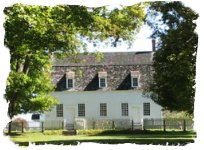 Shaker buildings are unique, having separate entrances for the Brethren and Sisters. Buildings and roles were typically segregated, with jobs being split between the groups (and completely managed by the Brethren or Sisters, respectively). Jobs, with the exception of teaching and medical, were rotated among the members on 6 week periods, with each Shaker expected to master all the jobs required by the community.
Shaker buildings are unique, having separate entrances for the Brethren and Sisters. Buildings and roles were typically segregated, with jobs being split between the groups (and completely managed by the Brethren or Sisters, respectively). Jobs, with the exception of teaching and medical, were rotated among the members on 6 week periods, with each Shaker expected to master all the jobs required by the community.
The relentless strive for quality and simplicity in their handiwork was simply an expression of their religion. Their work was their religion – doing your job as good as possible was worship to the Shakers, and second rate work simply wasn’t tolerated, as it was an affront to God. Of course, the Shakers spent a lot of time in worship services, like other religious based communities.
As an example of this dedication to quality – the Shakers made a cloak for Teddy Roosevelt’s wife, and she made a special trip to a Shaker village to accept the gift. Just prior to the ceremony, during the final inspection of the garment, it was found that a few of the stitches in an inside hem were slightly crooked. The first lady was not allowed to take the ''Dorothy Cloak' at that time – they sent her another one later.
Going back to the dancing – the religious ceremonies were one of the few times that the Brethren and Sisters spent any significant time around each other. Often, worship services were attended by 100’s of outsiders ‘from the World’, drawn to the intricate dances of the Shakers, and the singing of their beautiful hymns. Even today, to help gain a quick understanding of the Shakers, I feel you need do no more than listen to the famous Aaron Copeland arrangement of ‘Simple Gifts’. This beauty and simplicity of this Shaker tune says it all.
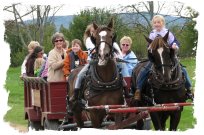
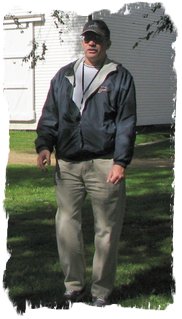 We would be remiss if we didn’t mention our tour guide, Roger Lyder. A
We would be remiss if we didn’t mention our tour guide, Roger Lyder. A
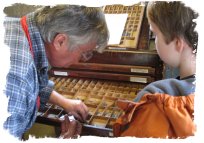
The village today offers multiple craft workshops, including broom making, furniture building, and box making. During our visit, multiple craftsmen were offering demonstrations. I particularly enjoyed a demo of cutting dovetail notches for joints. In the print shop, Vance went thru the entire printing process of printing his name on a card. Most historical print shops will demonstrate the use of the old presses, but this was the first time we’ve been able to work thru the whole process. With the help of the printer, Vance selected the metal type, set the individual letters of his name into a frame, and then printed off several cards on a small hand press. This process required a reasonable amount of effort, and illustrated the tremendous effort involved with typesetting an entire newspaper.
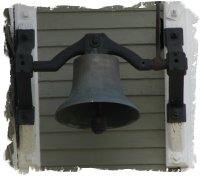 Vance also got to ring a Paul Revere & Sons bell in the schoolhouse. Because of the quality, the Shakers purchased bells from Revere in Boston, instead of from local smiths. The village has 2 orginal Revere bells.
Vance also got to ring a Paul Revere & Sons bell in the schoolhouse. Because of the quality, the Shakers purchased bells from Revere in Boston, instead of from local smiths. The village has 2 orginal Revere bells.
Intrigued by our visit, we picked up a copy of the Ken Burn’s video on the Shakers, which in the usual outstanding Ken Burns style, filled in some of the historical background, along with interviews with some of the surviving Shakers or people who had been Shakers in their youth, but left. Because of the festival going on at the site, we were unable to spend as much time as we might have liked going thru all the buildings and exhibits, so the Burn’s film was very helpful in filling in the gaps in our understanding.

Vance: The Shaker Village was an old village of people kind of like Nuns and Monks. They could not get married. Most of the children in the village were either orphans, or kids of the people who became Shakers. It mostly was an old fashioned place. There were about 27 buildings in all.
First we went on a tour of the village. It was one of the first places to have electricity. Next we went on a tractor ride called the Pumpkin Express. The tractor driver stopped in the middle of the ride so some of the people could buy a pumpkin. Then we went on a horse ride. We spent most of the day touring the village. Finally, we ate at the Shaker Table Restaurant.
P.S I also got to print out my own name in the print shop.
AN OLD VILLAGE OF THE OLD DAYS!
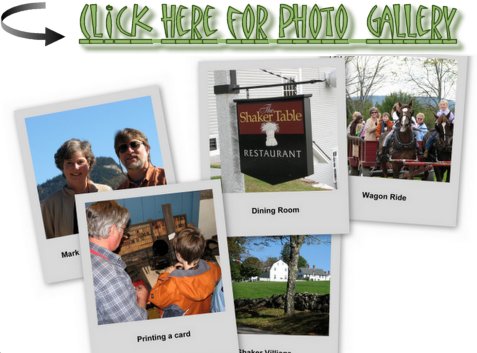







<< Home